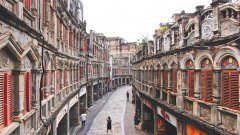China Focus: New ideas shine on International Museum Day
BEIJING, May 18 (Xinhua) -- A slew of events, including new projects and exhibitions aimed at appealing to visitors, were launched by various Chinese museums on International Museum Day Thursday.
Emperor Qinshihuang's Mausoleum Site Museum in northwest China's Shaanxi Province and Internet giant Baidu jointly announced a plan to digitalize the museum's world-famous Terracotta Warriors, the life-sized clay soldiers buried with the emperor in the Qin Dynasty more than 2,000 years ago.
They unveiled two new products available for viewing via mobile phone. The first is an ultra-high-definition 3-D display of the No. 1 and No. 3 excavation pits. The panoramic image was based on 1,000 pictures.
The second allows visitors to see 3-D images of warriors and horses in the No. 2 pit.
In the future, the company will use AI to reproduce higher quality scenes of the pits, according to the cooperation agreement.
In Beijing, a national exhibition on archaeological discoveries, the first in China in the past two decades, opened at the Capital Museum Thursday.
Nearly 400 artifacts from research institutes and museums across the country are on display, and many of which have never been seen outside of their discovery sites.
The exhibits, ranging from the Neolithic Age to the Qing Dynasty (1644-1911), include jade, porcelain, gold and silver, stone carvings and frescoes, which were mainly discovered in the recent 20 years. They were found in the city ruins, tombs, buried palaces and sunken ships.
Asia's largest insect museum, the Insect Museum of West China in the city of Chengdu, southwest China's Sichuan Province, hosted a spider show.
It was the first time spider fossils discovered in China have been displayed in a museum and also the first time live spiders have been shown in a domestic museum, according to curator Zhao Li.
Zhao said the show integrates the theme of this year's International Museum Day: "Museums and contested histories: Saying the unspeakable in museums."
"Spiders are just a controversial species," he said, explaining that while they are generally feared or disliked by humans, they do eat pests and have pharmacological uses.
Spider fossils are very rare, because their soft bodies usually rot before fossilization occurs. The two fossils on display, found in volcanic sediment, are believed to have lived about 165 million years ago in what is now Inner Mongolia. About 50 live spiders are also on display.
"We hope the live spiders, specimens, fossils and artworks we exhibit will help visitors learn to like, or at least stop hating or fearing, spiders," Li said.
In addition to shows, academic exchanges on the development of museums were also held. The newly-opened World Expo Museum launched its first WeTalk Conference Thursday, focusing on the values museums champion and their role in social education.
Dimitri Kerkentzes, deputy secretary general of the Bureau International des Expositions, said when addressing the conference, "Museums are more than repositories of history and culture. They provide evidence to the existence of different cultures, realities and histories in ways that cannot always be communicated in writing or in spoken word."
The museum is the first entirely dedicated to World Expos, showcasing the history, creation, and themes of International Expos since 1851. Located on the former site of the 2010 Shanghai World Expo, it opened on May 1. With eight permanent exhibition halls, the museum covers a total of 9,000 square meters, exhibiting more than 3,000 collections from around the world.
Chinese museums hold a total of 30,000 exhibitions each year, receiving 900 million visitors, according to the State Administration of Cultural Heritage (SACH). There were 4,873 registered museums in China as of the end of 2016, of which 4,246, or 87.1 percent, are open to the public free of charge, said Liu Yuzhu, director of SACH.
The International Council of Museums established International Museum Day in 1977 to raise public awareness of museums' roles in the development of society. In 2016, more than 35,000 museums in some 145 countries and regions participated in the event.















